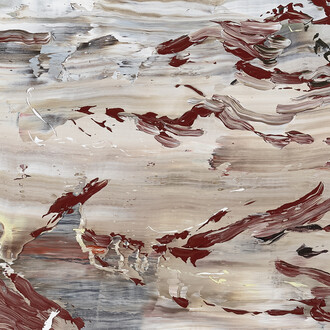In 1976, at the age of twenty-one, Emo Verkerk made his first artwork. He took an existing wooden kitchen chair and fitted it with an elongated seat of approximately one meter. The idea behind it was that a person who sits down on it, who is literally sitting on the edge of his seat, would become more active in space. It’s a remarkable start for someone who has made his name with portraits of historical figures, figures who could therefore never sit down on the chair.
The person portrayed might be a writer or a philosopher, a cartoonist or a fellow painter, an existentialist or a religious man, a rationalist or an idealist, a musician or a composer, an actor or a playwright, even a magician or a shaman. They all have one thing in common: once they are painted by Verkerk, they become an integral part of his universe, which turns out to be a world of its own. Like the chair, that symbolizes an entire oeuvre, you couldn’t make this up.
In his own words: “You can see my portraits as an allegorical journal: the people I paint represent thoughts or ideas that preoccupy me, that touch me. It is all about empathy. But the secret is in the direction. Because there is a patent on empathy. It doesn’t lie with me, but with the other who I’m portraying. He has the patent and that comes with a price. And the portrait is the actual prize. In short, empathy is not the means, it’s the end. See it as a sporting tribute to the person who is being portrayed, while all I get is the consolation prize.”
A relatively large number of these were alcoholics: think of Alfred Jarry, Francis Bacon, Joseph Roth, Venedikt Erofeev, Malcolm Lowry, Charles Jackson, Flann O’Brien, Dylan Thomas, and Thomas de Quincey, who claimed not to be addicted to opium, but to the alcohol in which it was dissolved. Or of more moderate figures like Arthur Rimbaud, James Joyce, or William Faulkner. But Emo Verkerk has now been on the wagon for ten years. He didn’t hit rock bottom, but made a soft landing on a puppy, his pet ever since. This became immediately apparent in his work, it now also features mammals. Maybe we are looking at a different paradigm.
During the first ten years he was mostly wrestling with Romantic projection. An orphan in the Dutch art world, stubborn enough to start looking for the cause. He eventually came to the insight that his practice comprises two kinds of projection: a pathetic projection, which he considered to be documentary, and a hopeful projection, which is conceptual in nature. This insight led to the penultimate phase: a phase of reflection, inaugurated by the construction of a number of compact objects, each representing a specific bird. The paintings from this period are structurally different: the persons that are portrayed feature in an environment that is also Verkerk’s. But the phase that stood at the origin of abstinence appears to turn everything around.
The perspective has changed. The illusion of the vanishing point, which since German Romanticism has been a symbol of Einfühlung and, in practical terms, of projection, in other words, of the future, is restored in its former glory. The representation emerges from a source which is a symbol of the past. The result is that the protagonists, like Biblical figures in Re-naissance paintings, present themselves in the here and now.













